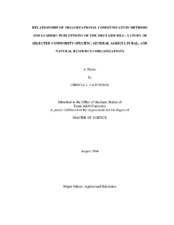| dc.contributor.advisor | Wingenbach, Gary J. | |
| dc.creator | Catchings, Christa Leigh | |
| dc.date.accessioned | 2005-11-01T15:49:31Z | |
| dc.date.available | 2005-11-01T15:49:31Z | |
| dc.date.created | 2004-08 | |
| dc.date.issued | 2005-11-01 | |
| dc.identifier.uri | https://hdl.handle.net/1969.1/2693 | |
| dc.description.abstract | The purpose of this study was to determine perceptions of organizational communication methods used by selected commodity-specific, general agricultural and, conservation or natural resources organizations to disseminate information about the Farm Security and Rural Investment (FSRI) Act of 2002 within their organizations. A secondary purpose was to evaluate if preferred organizational communication methods related to organization leaders?? perceptions of the FSRI Act of 2002. Previous studies have assessed organizational communication methods and members?? perceptions, but little research has been completed on the combination of these variables.
The instrument used in this study was derived from modified versions of Sulak??s (2000) 1996 Farm Bill survey, a similar instrument by Catchings and Wingenbach (2003), and Franklin??s (1975) organizational communication survey. The target population (N=300) was all selected Texas organizations?? board members. The accessible population (n=160) were selected Texas organizations (commodity-specific, general agriculture, and conservation or natural resources) board members. There were 70 respondents with a response rate of 44%.
iv
The respondents from this study were mostly board members from a commodity-specific organization and were 46 to 55 years old. They had attended college or completed an undergraduate degree, were raised on a rural farm or ranch, and currently live on rural farm or ranch.
The respondents from selected Texas organizations indicated that they had some knowledge about 17 of the 18 primary issues or programs in the 2002 Farm Bill.
Selected Texas organizations board members strongly agreed that their respective organizations wanted to meet their primary objectives and information about important events or situations were shared within their organizations.
The respondents strongly agreed with the statement ??farm organization coalitions were essential for enacting the 2002 Farm Bill,?? and ??farm organizations strongly influenced the 2002 Farm Bill.??
This study summated and correlated the perceptions of organizational communication methods and perceptions of influencers affecting the outcome of the 2002 Farm Bill. Through that correlation, this study can conclude there was a moderately significant and positive relationship between perceived organizational communication methods and perceived levels of influencers affecting the outcome of the 2002 Farm Bill. | en |
| dc.format.extent | 576931 bytes | en |
| dc.format.medium | electronic | en |
| dc.format.mimetype | application/pdf | |
| dc.language.iso | en_US | |
| dc.publisher | Texas A&M University | |
| dc.subject | Agricultural Communication | en |
| dc.subject | Organizational Communications Methods | en |
| dc.subject | Communication Methods | en |
| dc.subject | Perceptions | en |
| dc.subject | 2002 Farm Bill | en |
| dc.subject | Farm Policy | en |
| dc.subject | Farm Bill Perceptions | en |
| dc.subject | Organizations | en |
| dc.subject | Commodity-specific | en |
| dc.subject | General Agriculture | en |
| dc.subject | Natural Resources | en |
| dc.title | Relationship of organizational communication methods and leaders' perceptions of the 2002 Farm Bill: a study of selected commodity-specific, general agricultural, and natural resources organizations | en |
| dc.type | Book | en |
| dc.type | Thesis | en |
| thesis.degree.department | Agricultural Education | en |
| thesis.degree.discipline | Agricultural Education | en |
| thesis.degree.grantor | Texas A&M University | en |
| thesis.degree.name | Master of Science | en |
| thesis.degree.level | Masters | en |
| dc.contributor.committeeMember | Conrad, Charles | |
| dc.contributor.committeeMember | Briers, Gary | |
| dc.contributor.committeeMember | Rutherford, Tracy | |
| dc.type.genre | Electronic Thesis | en |
| dc.type.material | text | en |
| dc.format.digitalOrigin | born digital | en |


